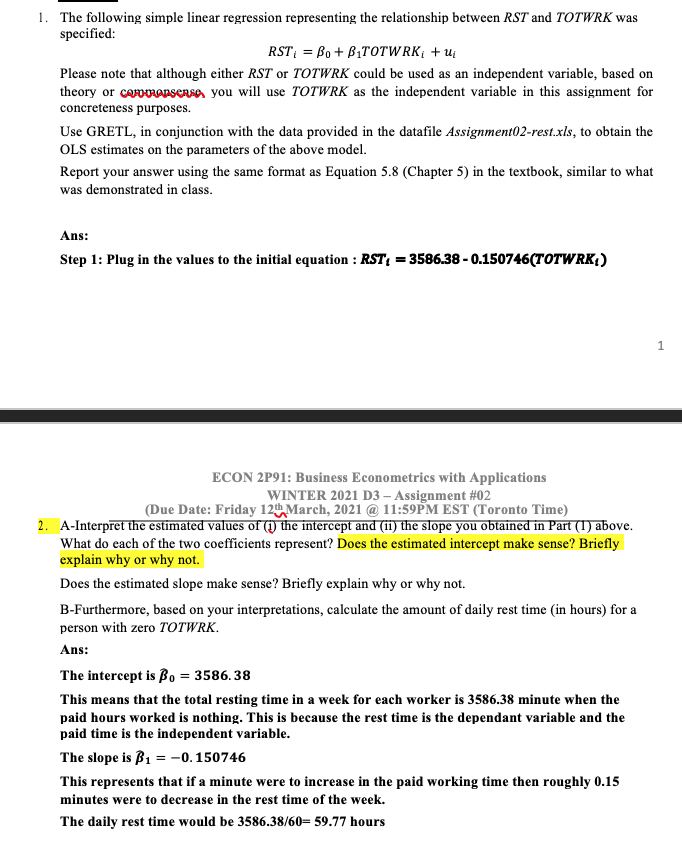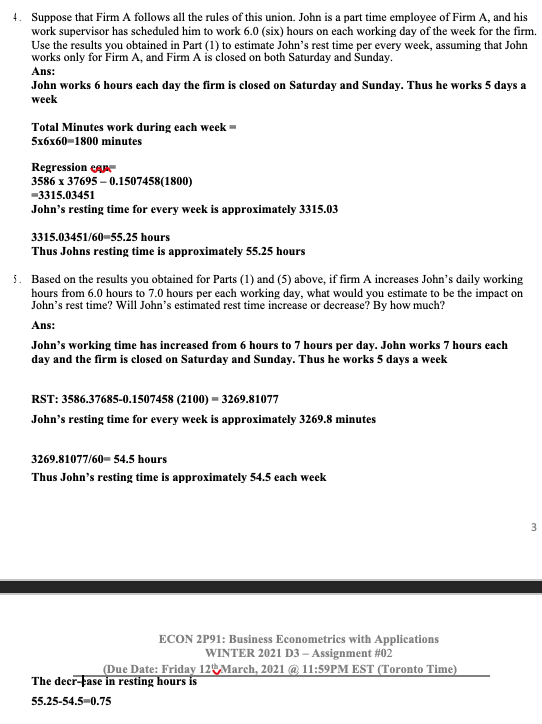


I . The following simple linear regression representing the relationship between RS?!" and I'OTWRK was specied: HST! = Bu + BJOTWRK; + to Please note that although either RS1" or I'OTWRK could be used as an independent variable, based on theory or m you will use TOWER" as the independent variable in this assignment for concreteness purposes Use GRETL, in conjunction with the data provided in the datale Assignmmr2restxis, to obtain the OLS estimates on the parameters of the above model. Report your answer using the same format as Equation 5.8 (Chapter 5] in the textbook, similar to what was demonstrated in class. Ans: Step 1: Plug in the values to the initial equation : RSI" - 353638 - disarmament) ECON 2P9]: Business Econometrics with Applications WINTER 2021 D3 Assignment #02 (Due Date: Friday llMarch. 2&2] @ 11:59PM EST (Toronto Time} 2. A-Inmprmmlmeplmmmmve What do each of the two coefficients represent? Does the estimated intercept make sense? Briey explain why or why not. Does the estimated slope make sense? Briey explain why or why not. B-Furthermore, based on your interpretations, calculate the amount of daily rest time (in hours) for a person with zero TOW. Ans: The intercept is u = 3586.38 This means that the total resting time in a week for each worker is 3586.38 minute when the paid hours worked is nothing. This is because the mt time Is the dependant variable and the paid time is the independent variable. The slope is 31 = 0. 150746 This represents that if a minute were to increase in the paid working time then roughly 0.15 minutes were to decrease in the rest time of the week. The daily rest time would he 3586.38f= 59.77 hours 4. Suppose that Firm A follows all the rules of this union. John is a part time employee of Firm A, and his work supervisor has scheduled him to work 6.0 (six) hours on each working day of the week for the firm. Use the results you obtained in Part (1) to estimate John's rest time per every week, assuming that John works only for Firm A, and Firm A is closed on both Saturday and Sunday. Ans: John works 6 hours each day the firm is closed on Saturday and Sunday. Thus he works 5 days a week Total Minutes work during each week = 5x6x60-1800 minutes Regression CAR 3586 x 37695 - 0.1507458(1800) -3315.03451 John's resting time for every week is approximately 3315.03 3315.03451/60-55.25 hours Thus Johns resting time is approximately 55.25 hours 5. Based on the results you obtained for Parts (1) and (5) above, if firm A increases John's daily working hours from 6.0 hours to 7.0 hours per each working day, what would you estimate to be the impact on John's rest time? Will John's estimated rest time increase or decrease? By how much? Ans: John's working time has increased from 6 hours to 7 hours per day. John works 7 hours each day and the firm is closed on Saturday and Sunday. Thus he works 5 days a week RST: 3586.37685-0.1507458 (2100) = 3269.81077 John's resting time for every week is approximately 3269.8 minutes 3269.81077/60- 54.5 hours Thus John's resting time is approximately 54.5 each week 3 ECON 2P91: Business Econometrics with Applications WINTER 2021 D3 - Assignment #02 (Due Date: Friday 12% March, 2021 @ 11:59PM EST (Toronto Time) The deer-pase in resting hours is 55.25-54.5 0.751. Use GRETL to obtain the correlation matrix between the two variables of RST and TOTWRK. 1 . Copy the correlation matrix you obtained using GRETL and paste it in your assignment work. b . Based on the results of the correlation matrix you obtained in (7.a), what is the nature of the relationship among the two variables? What can you judge about the extent of such relationship? C. Since the correlation matrix you obtained (using GRETL) does not include the value of the covariance, use the results you have obtained in here, in conjunction with any relative GRETL descriptive statistics, to find the covariance between RST & TOTWRK (show your calculations). d. Use the value reported in the correlation matrix to confirm the value of the coefficient of determination for the model obtained in Part (1) above. Does the calculated value of this coefficient match with the value in Part (3) above












